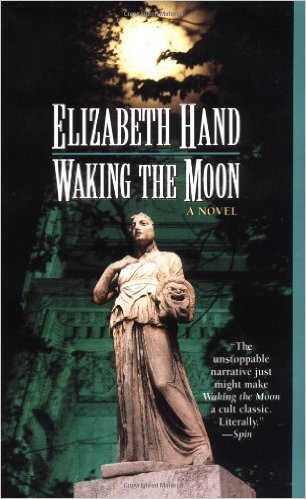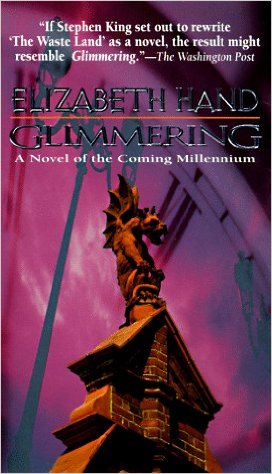Two Books By Elizabeth Hand

Elizabeth Hand. Waking the Moon. New York: HarperPrism, 1995. Pp. 387. ISBN 0-06-105214-0. $19.00. (Also available in paperback edition.)
(This review originally appeared in Mythprint 34:4 (#181) in April 1997.)
Reviewed by Eleanor Farrell
Elizabeth Hand: Fin de Siécle Fantasist
Waking the Moon
Waking the Moon, published in 1995 and winner of the 1996 Mythopoeic Fantasy Award for Adult Literature, is Elizabeth Hand’s fourth novel. I enjoyed the author’s earlier connected books – Winterlong (1990), Aestival Tide (1992) and Icarus Descending (1993) – for their dizzyingly decadent settings and opulent style, but Waking the Moon is definitely superior story-telling. It begins with Katharine Sweeney Cassidy’s arrival as a new student at the University of the Archangels and St. John the Divine, and the beginning of her friendships with the elegant and exotic Angelica and Oliver. All three characters are destined to play a role in the conflict between the Benandanti, a clandestine order controlling the Divine (and much of the rest of civilization as we know it), and the re-emerging blood cult of the Moon Goddess.
This brief synopsis doesn’t do justice to the complex and well-constructed plot of the novel. First, the book is enjoyable as an ‘alternate universe’ story, as the setting is juxtaposed on that of Catholic University in Washington, D.C. (where Hand got her college degree in anthropology). The National Shrine of the Immaculate Conception (“America’s Catholic Church”), located on the campus, is truly one of the most bizarre and baroque edifices ever constructed, and Hand uses it brilliantly as the centerpiece of the ‘Divine’, where tiny hidden chapels house prehistoric goddess figures and androgynous stone angels come to life. Sweeney, the central character of the novel, unknowingly becomes involved in the conflict between the Benandanti and the forces of the goddess, through experiences which destroy the life she’s begun at the Divine and leave her emotionally bereft. Then, twenty years later, she is given another chance. The story’s structure of ‘Departure, Absence, and Return,’ mirroring the classic anthropological initiation sequence, first creates chaos and then shapes it into a completely unexpected possibility of hope.
The author’s handling of both the patriarchal and matriarchal forces in this struggle is equitable; Hand calls herself (in an interview in Locus) “an equal opportunity destroyer – I’ll trash any kind of religious mumbo-jumbo, not just that whole New Age woo-woo stuff.” This refreshing approach, combined with solid research on both the early goddess‚centered religions and the activities of the ‘real’ Benandanti (discussed by historian Carlo Ginzburg), creates a fascinating tapestry of history and fantasy. Added to this careful construction is an impressive cast of intelligent, well-developed characters, and a downright exciting plot. Waking the Moon comes highly recommended.
Interlude
Having been duly impressed with her latest novel, I was thrilled to actually meet Elizabeth Hand at LACon III (the ’96 Worldcon) in Anaheim. Liz Hand is friendly and articulate with a delightful sense of humor (expressed very subtly in her books). We were co-participants, along with David Bratman and Tim Powers, on a panel titled “The Inklings and Current Fantasy” which was great fun. A transcript of the panel will soon be published in Mythlore, but I’ll give you a teaser of our recommendations: everyone should read Charles Williams (as well as Hand and Powers, of course). I asked about Hand’s forthcoming book, Glimmering, due out in February of ’97; she replied that it was very dark. She wasn’t kidding.
Glimmering
The novel is prefaced with appropriately dire quotes from W.H. Auden and Oscar Wilde, including this exchange from The Picture of Dorian Gray:
‘Fin de siécle,’ murmured Lord Henry.
‘Fin du globe,’ answered his hostess.
‘I wish it were fin du globe,’ said Dorian with a sigh. ‘Life is such a great disappointment.’
In 1997, a disastrous combination of ecological catastrophes results in vast rips in the ozone layer, causing flashes of spectral color to stream across the skies. This is the “Glimmering,” which is accompanied by climate changes, leading to drought and famine, as well as breakdowns of communication, electricity and other power sources. It is truly fin de siécle, as economic chaos clashes with decadent pop culture in a world plummeting toward the end of civilization. The characters in Glimmering – Jack Finnegan, publisher of the world’s last literary magazine; Trip Marlowe, golden-voiced and spiritually empty Christian rock star; documentary filmmaker Leonard Thrope, thriving on the morbidity of a dying world; Jule and Emma Gardino, traumatized by the death of their child; artist-turned-recluse Martin Dionysos – are intimately acquainted with death. Dying of AIDS, Jack has retreated into his decrepit mansion on the Hudson River to wait for the end, while Trip, having fallen prey to the hallucinogenic drug IZE, attempts suicide but survives to be haunted by the memory of a girl he met only once but must find again. Leonard Thrope, who seems to know everyone and connects the disparate characters populating the story, is reminiscent of Lord Henry Wotton in Wilde’s novel: the ultimate observer and catalyst of moral decay, using the death surrounding him to fuel his perverse artistic vision. Still, Thrope’s enthusiasm is strangely life-affirming, which gives the character a bizarre kind of charm.
The climax of the novel is a massive 1999 New Year’s Eve party, thrown by the huge conglomerate GFI Worldwide Inc., owner of the immense Pyramid building in New York City, where a controlled environment reconstructs the blue sky of summer or the night constellations now replaced by the Glimmering. GFI announces plans to repair the atmosphere with a fleet of dirigibles to be launched at midnight in celebration of the Millenium, while a Christian eco-terrorist group called Blue Antelope plans their counter-attack.
As with Hand’s earlier books, the complexity of interwoven plots and intricate characterizations make a story synopsis impossible.The theme, powerful and often overwhelmingly negative, will not appeal to some readers. I found the story somewhat slower and less focused and the characters not as compelling as those in Waking the Moon. (Unlike her earlier novel, which had several intriguing and individual women as central characters, Glimmering‘s cast is largely male, which probably influenced my reaction here.) The author has stated that this book is an attempt to write about transcendence. It is not an easy journey, but a hard, uncompromising look at endings with barely a hint of possible new beginnings. It is a rich book, however, and one which will require more than one reading to tap the lode within.
Incidental Reading
Carlo Ginzberg. The Night Battles: Witchcraft & Agrarian Cults in the Sixteenth and Seventeenth Centuries. Trans. John & Anne Tedeschi. Baltimore:The Johns Hopkins University Press, 1983 (1966).
Oscar Wilde. The Picture of Dorian Gray. Oxford: Oxford University Press, 1974 (first published 1890).
“Elizabeth Hand: Reflections of a Catholic School Girl,” Locus, October 1995, p. 6ff.


